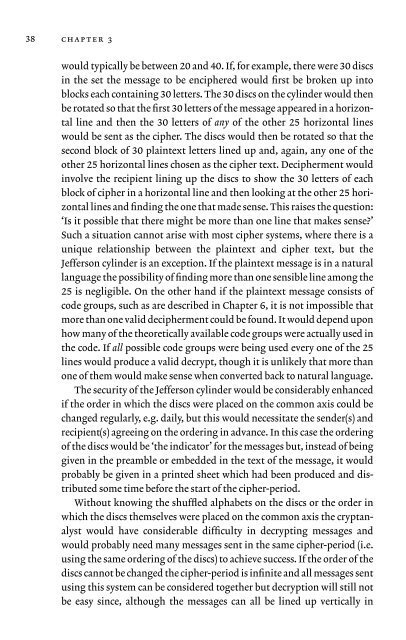Code and ciphers: Julius Caesar, the Enigma and the internet
Code and ciphers: Julius Caesar, the Enigma and the internet
Code and ciphers: Julius Caesar, the Enigma and the internet
Create successful ePaper yourself
Turn your PDF publications into a flip-book with our unique Google optimized e-Paper software.
38<br />
chapter 3<br />
would typically be between 20 <strong>and</strong> 40. If, for example, <strong>the</strong>re were 30 discs<br />
in <strong>the</strong> set <strong>the</strong> message to be enciphered would first be broken up into<br />
blocks each containing 30 letters. The 30 discs on <strong>the</strong> cylinder would <strong>the</strong>n<br />
be rotated so that <strong>the</strong> first 30 letters of <strong>the</strong> message appeared in a horizontal<br />
line <strong>and</strong> <strong>the</strong>n <strong>the</strong> 30 letters of any of <strong>the</strong> o<strong>the</strong>r 25 horizontal lines<br />
would be sent as <strong>the</strong> cipher. The discs would <strong>the</strong>n be rotated so that <strong>the</strong><br />
second block of 30 plaintext letters lined up <strong>and</strong>, again, any one of <strong>the</strong><br />
o<strong>the</strong>r 25 horizontal lines chosen as <strong>the</strong> cipher text. Decipherment would<br />
involve <strong>the</strong> recipient lining up <strong>the</strong> discs to show <strong>the</strong> 30 letters of each<br />
block of cipher in a horizontal line <strong>and</strong> <strong>the</strong>n looking at <strong>the</strong> o<strong>the</strong>r 25 horizontal<br />
lines <strong>and</strong> finding <strong>the</strong> one that made sense. This raises <strong>the</strong> question:<br />
‘Is it possible that <strong>the</strong>re might be more than one line that makes sense?’<br />
Such a situation cannot arise with most cipher systems, where <strong>the</strong>re is a<br />
unique relationship between <strong>the</strong> plaintext <strong>and</strong> cipher text, but <strong>the</strong><br />
Jefferson cylinder is an exception. If <strong>the</strong> plaintext message is in a natural<br />
language <strong>the</strong> possibility of finding more than one sensible line among <strong>the</strong><br />
25 is negligible. On <strong>the</strong> o<strong>the</strong>r h<strong>and</strong> if <strong>the</strong> plaintext message consists of<br />
code groups, such as are described in Chapter 6, it is not impossible that<br />
more than one valid decipherment could be found. It would depend upon<br />
how many of <strong>the</strong> <strong>the</strong>oretically available code groups were actually used in<br />
<strong>the</strong> code. If all possible code groups were being used every one of <strong>the</strong> 25<br />
lines would produce a valid decrypt, though it is unlikely that more than<br />
one of <strong>the</strong>m would make sense when converted back to natural language.<br />
The security of <strong>the</strong> Jefferson cylinder would be considerably enhanced<br />
if <strong>the</strong> order in which <strong>the</strong> discs were placed on <strong>the</strong> common axis could be<br />
changed regularly, e.g. daily, but this would necessitate <strong>the</strong> sender(s) <strong>and</strong><br />
recipient(s) agreeing on <strong>the</strong> ordering in advance. In this case <strong>the</strong> ordering<br />
of <strong>the</strong> discs would be ‘<strong>the</strong> indicator’ for <strong>the</strong> messages but, instead of being<br />
given in <strong>the</strong> preamble or embedded in <strong>the</strong> text of <strong>the</strong> message, it would<br />
probably be given in a printed sheet which had been produced <strong>and</strong> distributed<br />
some time before <strong>the</strong> start of <strong>the</strong> cipher-period.<br />
Without knowing <strong>the</strong> shuffled alphabets on <strong>the</strong> discs or <strong>the</strong> order in<br />
which <strong>the</strong> discs <strong>the</strong>mselves were placed on <strong>the</strong> common axis <strong>the</strong> cryptanalyst<br />
would have considerable difficulty in decrypting messages <strong>and</strong><br />
would probably need many messages sent in <strong>the</strong> same cipher-period (i.e.<br />
using <strong>the</strong> same ordering of <strong>the</strong> discs) to achieve success. If <strong>the</strong> order of <strong>the</strong><br />
discs cannot be changed <strong>the</strong> cipher-period is infinite <strong>and</strong> all messages sent<br />
using this system can be considered toge<strong>the</strong>r but decryption will still not<br />
be easy since, although <strong>the</strong> messages can all be lined up vertically in

















